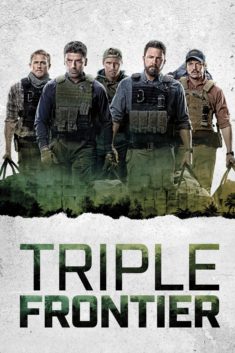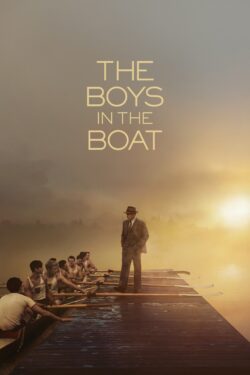Triple Frontier (2019)
Animal Action

In the scene where the soldier runs after a girl up a staircase and dogs in the alley in the background, the dogs were from that area, so they were acclimated to the environment. During the scene, the dogs remained a safe distance from the road, approximately 25-30ft. No vehicles were present in the alley. This was not an alley where vehicles could go. The dogs were let off leash and roamed the alley at liberty. The trainers remained in the alley, out of frame, and used verbal cues to keep the dogs in the shot.
In the scene where the helicopter crashes near a village and the mules react in the background, all the mules were held in a pen. The action of the helicopter was controlled and took place over a hundred miles away from the mules. No debris came close to the animals. When the simulation of the helicopter crash occurred, the trainers cued the mules to react.
In the scene where the soldiers walk onto a rooftop near a wire chicken couple with chickens inside, filming took place in a central community marketplace and on a rooftop. Prior to shooting, the animal wrangler brought eight chickens to the set. There were two chicken coupes approximately 4x8x5. The art department dressed the coupes with water and food bowls. The chickens were a safe distance from any action sequences. No action took place near the chickens.
When we see the actors talk at the edge of the village with mules, horses and goats in pens in the background, production provided safe set practices by purposely keeping a low level of talking while working on set. Wranglers were off-camera and making sure the animals were watered and fed all day.
In the scene where the actors leave the village leading a few mules, the mules were well mannered, accustomed to film set activity and noise, worked well together, and prepared for the action past the huts. The packs the mules wore were created by the props department and fitted to each of them individually. The packs were made of various types of small luggage and duffel bags. They were filled with cardboard and
Styrofoam in order to look like they were full. there was a lot of prep between wranglers, and mules. There was prep time before shooting began. The wranglers constantly worked with various actors and instructed them on how to handle working with the mules. There was a safety meeting each day before filming. Prior to shooting the scene, each actor was paired with his mule and instructed on the trail they would traverse.
In the scene where the men walk through the heavy jungle with the mules, prior to shooting the scene, the set was cleared of hazards and obstacles. There were many wranglers on set and over a couple weeks of prep. By the time they started shooting, the actors were well acquainted with the mules and how to work with them. They did short A to B trajectories in the jungle.
In the scene, where the actors lead the mules across the river, the scene was not filmed in an actual river, but a large pool with a green screen behind it. The pool will represent a rapidly moving river. The pool is rectangular shaped. Minor modifications were made to the pool in order for filming to take place. Buoys were set up inside the pool to help give directions for mules while they swam. The water was clean and chlorinated. In order to get the pool to make waves they used a water agitator, which was located at the far end of the pool. The American Humane surveyed the mules and the set prior to filming and found no significant hazards. Wranglers constantly worked with various actors to better their handling skills. A safety meeting was held before the mules and actors entered the pool. They discussed animal, set, water, and gear safety. Lifeguards were stationed around the pool to assist with human and animal safety as needed. Also wranglers and specific set construction personnel were set up to assist in the pool with any potential mule emergencies. The mules entrance and exit into and out of the pool was designed specifically for safety. A wooden ramp led from the side of the pool and the mules were walked down the ramp into the pool. Rubber mats were mounted onto the wood flooring to provide sure footing for the animals. Styrofoam padding was wrapped around the bars of the pipe corrals which lead to the pool in order to provide side safety. Additionally, a safety rope ran from one side of the pool to the other. There was a wrangler at the beginning of the trajectory holding the rope and a second wrangler at the landing point holding the other end of the rope. The rope was fed in between a small ring on the halter being worn by each mule. It guided the animal as it swam and provided a means to actually “hold” the mule at all times. The mules were given adequate timed breaks between takes for food, water and to relieve themselves.
ON ACTION- the mules were lead down the wooden ramp and into the pool. There was a wrangler inside the pool to catch each mule and send it across the pool. Each mule swam across the pool without an issue. Another wrangler was in the pool with the mules as they swam across, off-camera, near the actors. When the mules reached the other side of the pool, they walked up a ramp and entered a corral. At the corral, there was a wrangler to catch and loosen the rope on each mule. There were no issues in the filming of this scene.
In the sequence where the actors lead the mules on a mountain ridge and they stop to talk before a mule falls down the mountain, this scene was filmed at the base of rocky cliffs where production created a trail. A bluescreen was placed behind the trail to make it look as if they were on a mountain. There was an existing wide road at the base of the
cliff on which the trail was built. On action the actors led the mules down the trail, stopped for dialogue, then proceeded. Production also used a device which allowed the perception of a fall. The mule was positioned before the drop area. The drop device was a hydraulically operated platform made of 3/4 inch plywood covered with rubber matting and dirt. When activated the area dropped in a sloped, funnel-like fashion from the trail toward the open road. Prior to action, the wrangler attached a nylon 1/4” rope to the mule’s halter in addition to the lead line that the actor was holding. On action, the actors and mules remained stationary while the other actor walked across the drop area; as the mule walked on to the drop area, the hydraulics lowered the footing and simultaneously the wrangler turned the mule’s head toward herself to direct the mule off which the mule jumped to the stall mats below. The jump was mere inches off the ground safely achieved. The rest of the imagery was done in post, which made it look as if they mule fell off the mountain ridge to its death.
In the scene where the actor screams and runs the mules off the mountain side and the mules disperse, this was filmed on a safe slope, which the mules were accustomed to. The mules and actor rehearsed the scene. On action, the actor runs towards the mules. The wrangler off camera also cued the mules to run. The mules dispersed in different directions. A few wranglers were off-camera to retrieve the mules.




